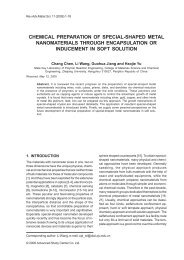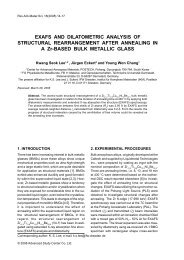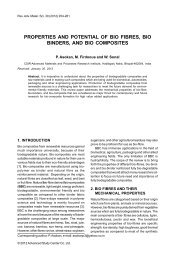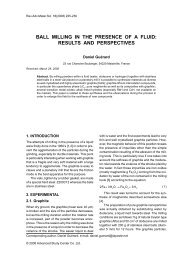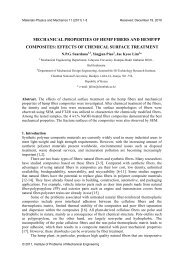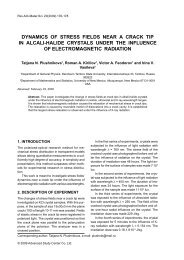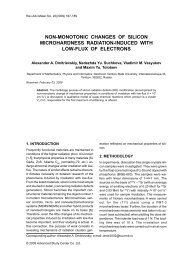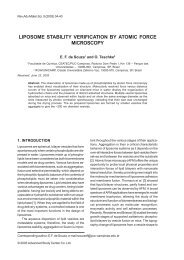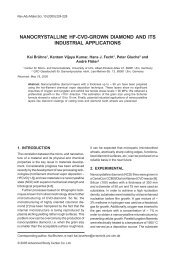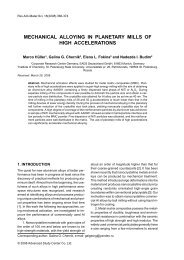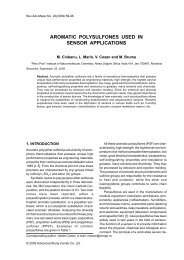surface pretreatment by phosphate conversion coatings – a review
surface pretreatment by phosphate conversion coatings – a review
surface pretreatment by phosphate conversion coatings – a review
You also want an ePaper? Increase the reach of your titles
YUMPU automatically turns print PDFs into web optimized ePapers that Google loves.
154 T.S.N. Sankara Narayanan<br />
infra red spectroscopy (FTIR), Raman spectroscopy,<br />
differential thermal analysis (DTA), differential scanning<br />
calorimetry (DSC), secondary ion mass spectrometry<br />
(SIMS), atomic force microscopy (AFM),<br />
glow discharge optical emission spectrometry<br />
(GDOES), quartz crystal impedance system (QCIS),<br />
<strong>conversion</strong> electron Mossbauer spectrometry<br />
(CEMS), acoustic emission (AE) testing, etc. were<br />
used to characterize <strong>phosphate</strong> <strong>coatings</strong> [308-340].<br />
SEM is the most commonly and widely used<br />
technique for characterizing <strong>phosphate</strong> <strong>coatings</strong>. It<br />
is used to determine the morphology and crystal<br />
size of <strong>phosphate</strong> <strong>coatings</strong>. SEM serves as an effective<br />
tool to study the nucleation and growth of<br />
the <strong>phosphate</strong> <strong>coatings</strong> and makes evident of the<br />
fact that the initial growth of the <strong>phosphate</strong> coating<br />
is kinetically controlled and at a latter stage it tends<br />
towards mass transport control [322]. SEM also<br />
substantiates the fact that preconditioning the substrate<br />
before phosphating enables the formation of<br />
a fine-grained and adherent <strong>phosphate</strong> coating.<br />
EPMA is used in the determination of the porosity<br />
of <strong>phosphate</strong> <strong>coatings</strong> in which the number of<br />
copper spots deposited in the pores following immersion<br />
in copper sulphate solution (pH 5.0) [323].<br />
XRD is primarily used to detect the phase constituents<br />
present in <strong>phosphate</strong> <strong>coatings</strong> <strong>–</strong> the<br />
phosphophyllite and hopeite phases in zinc <strong>phosphate</strong><br />
coating. Though the manganese and nickel<br />
modification of zinc <strong>phosphate</strong> coating reveals only<br />
the presence of hopeite phase, there observed to<br />
be significant variations in the orientations of the<br />
hopeite crystals as evidenced <strong>by</strong> the relative intensities<br />
of the H(311), H(241) and H(220), H (040)<br />
peaks. XRD is also used to characterize <strong>phosphate</strong><br />
<strong>coatings</strong> in terms their ‘P’ ratio.<br />
Van Ooij et al. [324] applied high resolution Auger<br />
electron spectroscopy (AES) in combination with<br />
energy dispersive X-ray spectrometry (EDX) to study<br />
the nature of chromium post passivation treatment.<br />
According to them, Cr(III) was not detected at the<br />
metal/<strong>phosphate</strong> boundry but on the <strong>surface</strong> of <strong>phosphate</strong><br />
crystals and that the Fe/Zn ratio was increased<br />
in the <strong>surface</strong> and sub<strong>surface</strong> layers.<br />
XPS is used to detect the nature of various species<br />
in <strong>phosphate</strong> coating. The presence of fatty<br />
acid-like contaminants on the metal substrates can<br />
be identified from the C 1s spectra. Similarly, the<br />
Zn 2p 3/2 and P 2p spectra enable identification of<br />
Zn 3 (PO 4 ) 2 . Besides, the formation of ZnO or Zn(OH) 2<br />
and NaHPO 4 could be identified from the Zn 2p 3/2<br />
and P 2p spectra, respectively. The Fe 2p 3/2 will give<br />
an idea about the presence of Fe 2 O 3 and FePO 4 in<br />
the coating [187]. Cu 2p spectra obtained from the<br />
sample <strong>phosphate</strong>d using a solution containing 1<br />
ppm of Cu 2+ ions show two components at binding<br />
energies 933.6 eV and 932.2 eV [325]. The former<br />
signifies Cu 2+ , although the latter could arise from<br />
either Cu + or Cu metal. All evidence supports the<br />
Cu deposition occurring during the phosphating process.<br />
ESR is used to confirm the modified structure of<br />
hopeite films formed on the <strong>surface</strong> of pre-treated<br />
steel sheets. The zinc <strong>phosphate</strong> film formed from<br />
the bath that does not contain manganese or nickel<br />
ions exhibits no ESR signal. This is because ESR<br />
could only detect paramagnetic transition metal ions<br />
with an unpaired electron whereas in zinc <strong>phosphate</strong><br />
coating the ten electron spins of zinc (II) metal ions<br />
(3d 10 ) in the ‘d’ orbitals are paired with one another.<br />
However, ESR detects the manganese and nickel<br />
components in the modified zinc <strong>phosphate</strong> coating<br />
and proves that manganese and nickel exist as<br />
Mn(II) and Ni(II) in these <strong>coatings</strong> [316].<br />
XRF is used to determine the nature of nickel in<br />
nickel modified zinc <strong>phosphate</strong> coating. The XRF<br />
spectrum obtained for metallic nickel is compared<br />
with that of the modified zinc <strong>phosphate</strong> coating.<br />
The Ni L α peak of metallic nickel occurs at 34.18°<br />
whereas the Ni L α peak of the nickel component of<br />
modified <strong>phosphate</strong> <strong>coatings</strong> occurs at 34.06°, indicating<br />
that the nickel component in the films is<br />
not in the metallic state [316].<br />
EXFAS was used to assess the crystal structure<br />
of manganese modified zinc <strong>phosphate</strong> coating<br />
[318]. The radial distributions of the first<br />
neighbouring atoms appeared at a distance of 0.146<br />
nm for unmodified hopeite and at 0.144 nm for manganese<br />
modified hopeite. This decrease is due to<br />
the disorderness of modified zinc <strong>phosphate</strong> coating<br />
following the introduction of manganese. EXFAS<br />
study also confirms that the manganese component<br />
is substituted for zinc component in the octahedral<br />
structure.<br />
SIMS was used to detect the presence of titanium,<br />
which are adsorbed on to the metal <strong>surface</strong><br />
and act as sites for crystal nucleation [313].<br />
The crystal structure of hopeite and phosphophyllite<br />
are hydrated. So once heated, dehydration<br />
reactions are expected to occur. Differential thermal<br />
analysis (DTA) performed on <strong>phosphate</strong> <strong>coatings</strong><br />
shows that there is a clear disparity in the dehydration<br />
process of these two phases as evidenced<br />
<strong>by</strong> a 50 °C difference in temperature in the endothermic<br />
peaks corresponding to hopeite and<br />
phosphophyllite phases. In the case of nickel and



